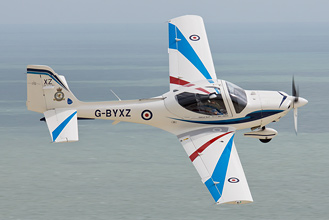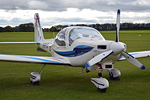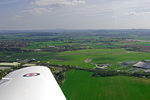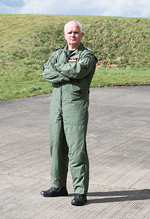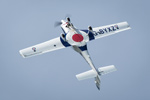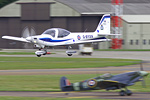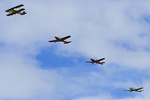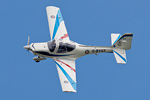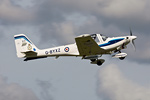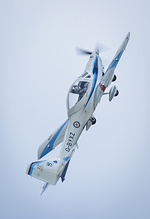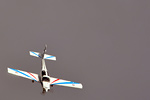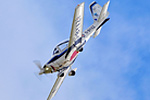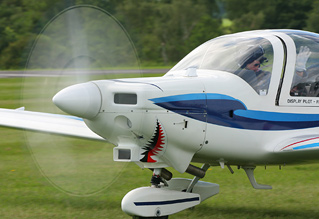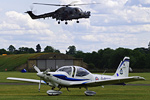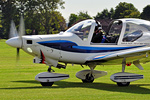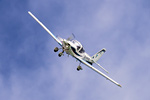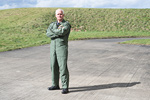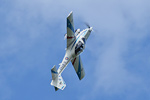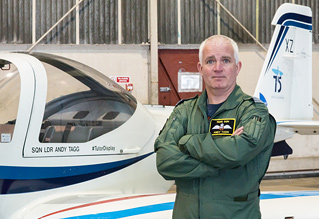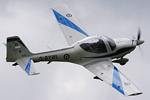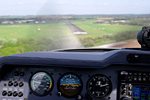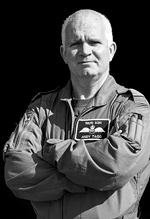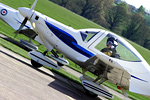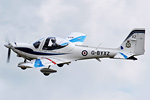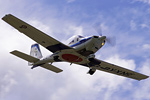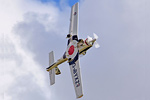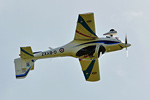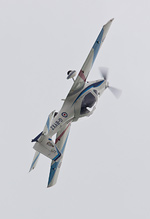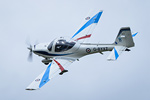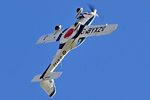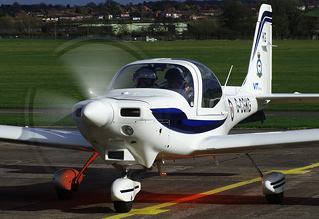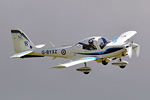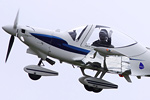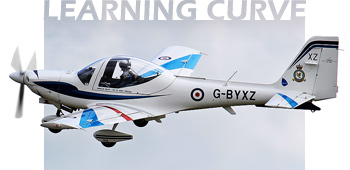
RAF Tutor Display 2017
Tuesday 21st March 2017
After an absence from the display circuit in 2016, the RAF Tutor Display returns to the display circuit in 2017 from a new home with 6FTS at RAF Wittering. After his fourth season displaying the Tutor - producing one of the best displays of the aircraft yet - Flt Lt Andy Preece has passed the display baton onto Sqn Ldr Andy Tagg for the 2017 display season. With little over two months before the first display of the season, preparations are well underway both in the air and on the ground as the two aircraft - affectionately known as 'Mike' and 'Zed' - return to display action.
travelled to RAF Wittering to interview the new RAF Tutor Display pilot, Sqn Ldr Andy Tagg, for a UK Airshow Review exclusive.
Joining the Royal Air Force over thirty years ago in 1986, Andy has flown a great variety of types including the Harrier, Hawk, Tucano and Tutor. RAF Wittering has been a constant in his career where he was first stationed between 1994 and 1997 "flying Harriers on 1 Squadron; where I carried out operations over Northern Iraq and the Balkans as well as exercises around Denmark and Alaska. From there I went to Linton-on-Ouse to be a QFI on the Tucano for three years and came back to Wittering for a year on the OCU as an instructor on the Harrier before being promoted to Squadron Leader and sent to Valley on 208 Squadron as a Flight Commander, where I did two and a half years. It was then back to Wittering as Squadron Leader (Ops) for another two and a half years, and then back to the Harrier as a QFI until the Harrier force folded in 2010. After that I went off to the CFS exam wing to be OC advanced examiners, flying primarily Hawks and Tucanos. Then six months in Afghanistan before onto the Tutor as OC East Midlands UAS; where I was until the end of February this year." Since then Andy has been back at RAF Wittering preparing for a very different role, as the RAF Tutor Display pilot.
Given that display flying is often something new to the RAF's solo display pilots, without experience of different display sites from previous seasons, how are the preparations for the season designed in order to prepare for coastal locations, away from the familiar environment of RAF Wittering?
Ultimately, what I'm trying to do at this early stage of my preparation is to get a feel for the sequence, over familiar territory, so that I can identify known features on the ground that can be taken and transposed to another site when I get more familiar with the display. Therefore, rather than just aiming at a specific point on the ground, I can make the picture fit the display site. All of the initial practices are done at Wittering and as I get more experience I can move to other airfields, which will still be under supervision at this early stage - but I can then go and try applying that picture at different locations. Preparing for the coastal side of it, again, is very different and I'm not going to practice that until I've got my PDA (Public Display Authority) and then I'm planning to go to one of the Air Weapons Ranges, either Holbeach or Donna Nook, to practice over MOD land - which is an important factor for the practices, but over a coastal site, so that I get a feel for how that works as well. It's very much a stepping stone process, building block approach, which is how we treat all of our training. So I started at 3000ft, I've done sorties at 1500ft, and I'm now down at 1000ft, and after another three sorties at 1000ft minimum, I can come down to 500ft - which is ultimately going to be my base height.
How does descending through the various heights of the display practice alter the dynamics of flying the display?
It makes it a lot easier, because you can see more the lower down you are. If you're higher up it is difficult to see the line that you are trying to work with when you are above it because you can't see down through the floor of the cockpit - so lower down I can see the line in front of me, so I can work out where it is. How that will work at a coastal site remains to be seen as I have no experience of that but I'm talking to a lot of people who have; so they are giving me a lot of good advice.
Has there been a great support network formed between the ex-Tutor Display pilots to help with preparations for the season ahead?
Yes, very much so. Andy Preece did it for four years (2007, 2008, 2014 & 2015) so he has a lot of experience flying the aeroplane within the display context. I've also spoken to Alan Wade, who displayed the Firefly for a lot of years - so a very experienced light aircraft display pilot - and have taken a lot of advice from them on what type of maneuverers to put in the sequence, what direction it is best to fly them (in terms of the wind) to try and keep the display as balanced as possible, even in conditions like today with 25 knots from crowd left as it would be. From what I've seen and heard of the whole display circuit, all of the display pilots have a great comradery and will give you lots of good advice rather than just pick holes in what you are doing.
How has the lack of power that the Tutor provides challenged the formation of the sequence?
The lack of power is an interesting factor because there are lots of maneuverers that you'd like to include but it just doesn't have the power to drive it through; it's not an Extra, I'd love it to be… or even a Firefly to be fair, so it does struggle with energy management; so it is very much a case of how you fly the maneuverers. Other display pilots in the past have started high and used that kinetic energy to maintain their energy until they've got to a base height. My sequence starts level and stays level throughout, so it's all about energy management during the manoeuvres, which is why it is a relatively simple sequence because anything that is a bit more complicated bleeds the energy and then you find yourself in a hole. The lack of power is a limiting factor, but it's not an insurmountable problem and I'm reasonably happy with the sequence that I've put together and the way it seems to flow and I'm hoping that everybody who is out there throughout the season will enjoy it as well.
In forming the display sequence for the year ahead, has anything new been included to look forward to and how does it vary compared to other years?
One of the things that Andy [Preece] said to me was that over the four years his display got simpler and simpler as it went along, so I've taken that simple theme and made it even simpler - just by virtue of the fact that I'm not as experienced as he is. I've added some stuff on the 45-axis whereas Andy's routine was mostly either on the A-axis or the B-axis, and I thought that I'd like to fan it out a bit more. So I use the A, the B and the 45 axis, to make it a more semi-circular type of approach. I'm not a big fan of negative G - and neither is the aeroplane - so I've taken all of the negative G stuff out, so you won't see me pushing out of anything or pushing up into anything. But what I have done is try to introduce my take on a rolling circle, it's not a pure rolling circle but it's a circle with a few aileron rolls thrown in, which is my kind of addition if you like. But there's nothing particularly new apart from that from the Tutor perspective.
How does that vary from the day-to-day application of the Tutor in the training role?
Apart from that rolling circle, all of the other manoeuvres in the sequence are manoeuvres that you could reasonably expect and experienced student to have been taught. We would teach them how to do half cubans, half horizontals, loops, stall turns etc, so there is nothing in there that is particularly challenging or unusual, apart from the rolling circle. All that is, really, is a combination of a normal level turn with a few aileron rolls thrown in.
How much does the sequence have to alter to fit the display lines at a given venue and how much of a challenge is that, given the small size of the Tutor?
It is reasonably challenging, a lot of it will depend on the wind as I found out today; with a bit of wind (we are talking about gusting 15-25 knots today) it stretches the sequence out naturally. So the challenge for me on a windy day is actually to keep it small, on the smaller display lines. I'm allowed to insert aileron rolls and barrel rolls within my sequence to stretch it out or get back into wind, but the sequence is the sequence, I'm not allowed to change it apart from doing that. So it will be a case of having to look at the display line, compare it to the Wittering runway and then decide whether I need to make the sequence longer and then how to do that.
How many different tiers (full, rolling, flat) is the sequence prepared at?
I've got two tiers, the full sequence and the flat sequence, which was from the previous display pilot's advice. The full sequence itself is more like a rolling sequence than a full sequence. It has stall turns and looping manoeuvres in it but rolls don't take much less height in the Tutor, so we just stuck with full and flat. Unlike RAFAT, as their full routine is 6000ft and their rolling is 4500ft and their flat is 2000ft, so there is a significant difference. There is 500ft for me between full and flat, so it isn't really worth having anything extra in between.
Are there any plans to apply a special display livery to the aircraft for 2017?
We are staying with exactly the same markings that Andy had for the aircraft in the 2015 season. With the roundel on the belly and the two red and blue flashes on the wings, with my name painted on the side rather than Andy's; and by the time that the season comes along the aircraft will belong to 6FTS so they will have the 6FTS crest on the tail. I like those markings because it gives the crowd something else to look at while the aircraft is manoeuvring so I try and show as much plan form, whether it's from underneath or on top, so that there is more than just a white dot to look at.
Are the aircraft modified in any other way for display action?
The one thing that we have fitted to the aircraft is an accumulator in the oil system, there's a changeover valve between the positive G and the negative G oil system, which is effectively just a ball bearing, that depends on which way up you are to where it goes. That period between positive and negative G, where the ball bearing is sometimes unsure as to where it needs to be. So there is an accumulator fitter to smooth out that flow of oil, to make sure that the engine keeps running during that transition period. Most of the aircraft now have had it removed because they've modified the oil system and it is now proving to be reliable, it is just that risk mitigation, for if there is a failure of it, the accumulator will continue to provide that oil pressure when I'm upside down at 500 feet, which is a point where you really don't want the engine stopping! Apart from that it is a standard Tutor that a student would fly on a daily basis.
In order to increase the presence of the relatively small aircraft, would a smoke system added to the aircraft be possible/desirable?
I think it would be an interesting addition; there are two reasons why it is not particularly feasible though. The first is the weight, how much would a system like that weigh? We've already mentioned the fact that the aircraft is relatively low powered and you struggle to maintain any energy, so if that would weigh anything more than 50 kilos then it would make the display very difficult to manage. The other problem with a smoke system, as the Reds have to deal with, is it shows up all of the nuances of the sequence so on a day like today, where I'm constantly adjusting for wind it won't be a nice smooth smoke trail; there will be all sorts of wiggles and jiggles in it and I think actually it might detract from - rather than enhance the sequence. It would be nice, but there are probably more cons than there are pros.
In the past, a joint arrival of the Tutor and a Scottish Aviation Bulldog has been popular in providing a past and present element to the display, has anything similar been planned for the season ahead?
It's something that I would like to do, what I haven't done yet is speak to anyone out there and is going to be around on the display circuit that flies anything like a Bulldog or a Chipmunk, that we could usefully put together to show the 'then and now' of training aircraft. It would be nice to put the Tutor with the new Prefect but I think it is too early days for that, so it's something that might come next year. But again, I'm not sure that the Prefect is going to find its way onto the display circuit just by virtue of the fact that the company are tasked to deliver flying training and there won't be that extra line in the contract for display flying. Unfortunately, I think the Bulldog is not on the circuit this year, so that's not going to happen, but I'll start putting some feelers out and see what I can do, because it would be nice to arrive with a mixed formation at some point.
How is the transition from training on the Tutor to the Prefect being prepared for?
Ultimately, what is going to happen is that the Prefect is going to be responsible for delivering Elementary Flying Training for the RAF, which means that the Tutor will stop doing that. What will happen in regards to 6FTS though, is that 6FTS will continue flying the Tutor for the foreseeable future. The transition from Tutor to Prefect is ongoing, the first instructors are due to start training in the next couple of months and the first course is scheduled to start towards the end of this year.
The Tutor Display Team may not have the same crowd pulling power as the Red Arrows or Typhoon, but how important is the Tutor display in terms of the entire RAF display package?
I think it is important that the Air Force showcases itself as a whole; when you think about what the Air Force did in terms of display flying even ten years ago, there were a lot more types in the inventory, a lot more types on the display circuit. And now, you've got the Red Arrows, the BBMF, the Typhoon and the Falcons Parachute display team and they really were the stalwarts for last season. The more the RAF can do in display flying, the better it is for the RAF. To showcase itself at the early stage - my son is in the Air Cadets and he can go flying in that aeroplane, then go on to the University Air Squadron and fly in that, and ultimately onto the Typhoon, or whatever becomes the goal for everybody to achieve. The Air Force is very limited in terms of what it does with regards to display flying, so anything is a very valuable addition to it.
With that in mind, what were the factors in allowing the display to return after its break from the display circuit?
The factors in bringing it back were the stand up of 6FTS, as a separate organisation - with the UAS, separating from 3FTS. 6FTS are going to run with the Tutor for the foreseeable future, and decided that because the UAS doesn't have a line as such whereas EFT were struggling with achieving their line, which is why I think they stopped the display. 6FTS doesn't have a line per se, so they were keen to bring it back in as a recruiting tool, as much as anything else - to promote the fact that the air experience flights are there and they fly thousands of Air Cadets a year, with the University Air Squadron also having a thousand students who we teach to fly the aeroplane, promoting the organisation and the Air Force as a whole.
More than ever the team's public engagement occurs away from the airshow environment, how important is the role of social media engagement in the overall presentation of the team?
I think it is as important as the presence on the ground at the airshow; nowadays so much is done on social media. What we are trying to do is not just raise awareness of the Tutor Display, but what the Tutor Display stands for. The way that we are organising the display this year is through four pillars. We are in the 'Generate' phase at the moment, we've got the 'Deliver' phase - which is the season itself, and we've got the 'Account' phase - which is about governance and supervision which takes place during the generate and deliver phases as well as post-season. Probably, most important of all is the 'Exploit' phase - which starts now - starting to put our message out to the general public and whether that is through articles in magazines, online magazines or through Facebook or Twitter. Which is something that we need to keep going with regular feeds about progress. The lower we get [through the display heights] the easier it will be to get photographs and put those out there too, so people can see that it is making progress.
Part of the 'Exploit' phase has involved a competition of the team's Facebook page to name the team's character 'Toot', how important are things like that in engaging with the public?
I think it is really important that we have an identity that is not just the 'RAF Tutor Display Team', instead something that is a little bit fun. The character has been ongoing for several years coming from the previous display pilot, Andy Preece, as his idea and artwork which he changed slightly every year. So I got together with him. If you look at it really closely you can see that it is kind of in the shape of a 6, to symbolise 6FTS. We had a play with the wingtip and stuff and I thought that naming it would be a nice way to engage people and get them involved, which we are going to try and keep that going as the year goes along.
How is the season building up in terms of the number of shows?
We've deliberately kept it small this year for a number of reasons. One is that it is the first time that 6FTS has done the display and although you could say that we can lift it straight from 3FTS and plug and play almost, it's not quite as simple as that. So 6FTS want to prove the concept with this year, so do enough that we are out there, but not do too much that we are working too hard and over stretching ourselves. I think it is much better to do it small and well, rather than big and badly. So we have tried to spread the season out and spread it around the country as well, so that we are represented in most areas - the South Coast is unfortunately a little bit lacking this year, but that is timing of displays versus my holiday that had been booked before I became the display pilot. We are doing Sunderland, Ayr, Portrush, Southport, Clacton and Wales amongst others, so we are around the country which is good.
When does the process of arranging the logistics of transportation etc. begin?
Now really. We are in the process of trying to find somebody who is prepared to support us with transport, so that we don't have to burden station MT with it. At the end of the day, we can get vehicles from MT but it is nice to have your own that you can leave stuff in - from one week to the next - rather than having to unload it and give the vehicle back to MT and then reload it again. But where we are going and how we are going to get there is already starting to look at and decided, because there are some displays where they're almost concurrent, so you've got to decide who is going to be on the ground at each event. The big one for me is Ayr and Portrush, they are on the same day and there's an Irish Sea between the two, so we'll be getting a lot of support for the Portrush show from the Northern Ireland UAS. The idea is that each UAS that is closest to the displays that we do will give us ground support, so the team manager will arrive and he's got two or three other bodies there who can help him, allowing them to engage with more people.
How important are the team's supporters, such as Babcock in enabling the display?
Babcock are really important because without them there wouldn't be a display, because as I've already said with the Prefect, the display part of the current contract with Babcock. So, them allowing us to use the aeroplanes, to put stickers and markings on the aeroplanes that make those aircraft stand out as display assets, to allow us to take engineering support when we go away at weekends is really important, we couldn't do it without them. So they are more than supporters, I'd classify them as a partner in the display. As far as other supporters are concerned we are still looking at trying to get support from other companies, whether that is through the loan of other vehicles, so that we've got something to drive up to wherever we are displaying, or to buy all of the gizzets that we give out to people at displays; they are all donated by other supporters. So that we give out things to people, which is always nice, when people come to see you it is always nice to give them a sticker or a pen or something - as it gives them something to take away from the Tutor stand.
What is the process between this point and the start of the airshow season?
I have three more sorties at 1000ft before I can come down to 500ft, and then practice at 500ft until I am comfortable with it and I get my PDA, which is when AOC 22 training group will come down here and will watch me do my thing and he will say that he is either happy with that or not. If he is not happy with it then I'm not sure if he will give me some advice and say that you need to change that or that or it will be forget it it's a complete shambles, so that is scheduled for May 9th. Which then gives me a month before my first public display, which is Retro Festival up at Newark on the 10th June. So then, it is keeping in reasonably regular currency, I've got to fly at least one sequence every seven days, so just weekly practices to keep my hand in. During the season the displays count towards the currency, so there may be the odd practice to keep current but that is it really, just keep going until my last display which I think is Southport in the middle of September.
Scott Perry and everyone at UK Airshow Review would like to thank Andy and the RAF Tutor Display Team for their time and hospitality in allowing the interview to take place, and wish them the best of luck for the season ahead.
